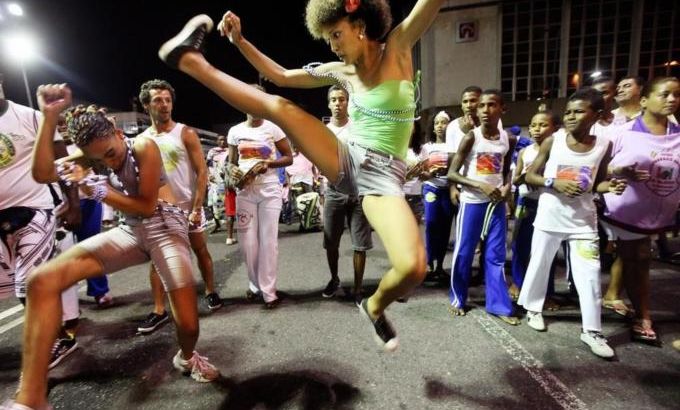Carnival kicks off across Brazil
The country’s organisational expertise is on display as millions join raucous celebrations.

Rio de Janeiro, Brazil – The streets of the Cinelandia neighbourhood were jam-packed with humanity on Saturday as an estimated 1.8 million people took part in the O Cordao da Bola Preta, one of the city’s largest and oldest street parties or blocos.
This year marked the party’s 95th anniversary, and for an idea of how big this party is, there were an estimated 400,000 less participants than last year.
Carnival has kicked off all over Brazil, and nowhere are the festivities more famous than in Rio.
There were nearly 500 blocos sanctioned by the city of Rio the past week. They’re often called the “people’s carnival”, because they’re mostly free and held in dozens of neighbourhoods across the city.
The parties are usually a mix of thousands of sweaty bodies, minimal inhibitions and clothing, often outrageous costumes, samba dancing, and Rio’s energised party culture all mixed together in one intoxicating cocktail.
Or as Marcelo Tyson, a party-goer at a bloco in the historic Santa Teresa neighbourhood, told Al Jazeera: “Rio’s carnival blocos symbolise heaven and hell mixed together in a blender.”
Yearly security test
|
“Carnival is a good time to show our expertise in managing of big crowds.“ – Antonio Pedro de Mello, Rio’s tourism secretary |
Local officials say last year’s Carnival brought out 5 million people to the streets in Rio, and this year they expect that number could reach 6 million.
With Rio hosting the 2014 World Cup and the 2016 Summer Olympics, there is a lot of talk – mostly from outside Brazil – about how the city can manage security at such large events.
But local officials point to Carnival as an example of how the city is prepared and experienced with big events.
“The street carnivals in Rio are a lot bigger than the Olympic games in terms of the event and the number of people,” Antonio Pedro de Mello, Rio’s tourism secretary, said recently in a press conference. “So Carnival is a good time to show our expertise in managing of big crowds.”
At a city operation command center, opened in 2010, hundreds of agents from dozens of city agencies monitor 560 city security cameras, 24 hours a day. They’re watching the cameras for everything from thieves to traffic problems to potential security threats.
As Brazil is one of the world’s most active consumers of social media, the operations center updates the public and gets feedback via a Twitter feed.
Nearly 7,000 extra police officers are on the streets of Rio at any given moment during Carnival.
Subdued celebrations
Rio’s Carnival is undoubtedly Brazil’s most well recognised globally. The city invests millions of dollars each year to hold the main Carnival parade events, held in the its newly renovated Sambodromo stadium.
But Salvador and Recife – and, to a lesser extent, Sao Paulo – also host massive Carnival street parties and parades that some argue are just as grand (and less commercialised) than in Rio.
And thousands of other smaller cities in Brazil also host yearly carnivals, and this year have decided to cancel festivities.
The northeast of Brazil is struggling through the worst drought in the past half-century, which has forced several small towns in the interior of that region of cancel their carnivals.
In the southern Brazilian state of Rio Grande do Sul, where a nightclub fire two weeks ago in Santa Maria killed 238 and injured more than 100, 25 towns have cancelled their annual festivities this year. (Fifty-eight people still remain hospitalised).
And in more than 20 other cities in Brazil, Carnival has been cancelled so the public funds that would have been used for the festivities can be re-invested elsewhere.
|
“Not having Carnival is very bad, because Carnival is part of our culture and it’s a tradition in this region.“ – Cristiane Goncalves |
The city of Itatiaia (population 29,000) normally hosts a parade that would bring an additional 20,000 people to the town. But this year the mayor cancelled it after the local fire chief said that with the extra people, the city would not have sufficient emergency pathways in the event of an emergency.
The city is taking the roughly $175,000 in public funds they normally spend on the carnival and instead are buying two new ambulances for the public hospital and a public day-care centre.
The move has been controversial in the town. “Not having Carnival is very bad, because Carnival is part of our culture and it’s a tradition in this region,” Cristiane Goncalves, a local resident, told Al Jazeera.
But Solange de Miranda disagreed, saying money was better spent elsewhere. “It’s good this money is being put into the people’s priorities and not into entertainment,” she said.
Daniel Sampaio, the town’s secretary of economic development, told Al Jazeera they expect to hold the carnival again next year.
Party goes on in Rio
There are no financial worries in Rio de Janeiro – at least not at Carnival – and the party is forging ahead at full speed.
On Sunday and Monday nights, the most famous (and colourful) samba schools parade down the Sambodromo stadium in front of tens of thousands of people. The parade starts at 9 pm local time, and won’t end until about 7 am the next morning each day.
Hotels in the city are packed, the streets overflowing, the blocos continuing unabated. And amid all the madness, 17,000 tourists on 8 cruise ships arrived in Rio’s main port on Sunday morning.
If that weren’t enough, the temperature is about 39 degrees Celsius, or 102 degrees Fahrenheit.
Next year Carnival in Rio will have the added hype and hysteria of happening just months before the opening of the World Cup.
Rio will be fine. But the rest of the world? Brace yourself.
Follow Gabriel Elizondo on Twitter: @elizondogabriel